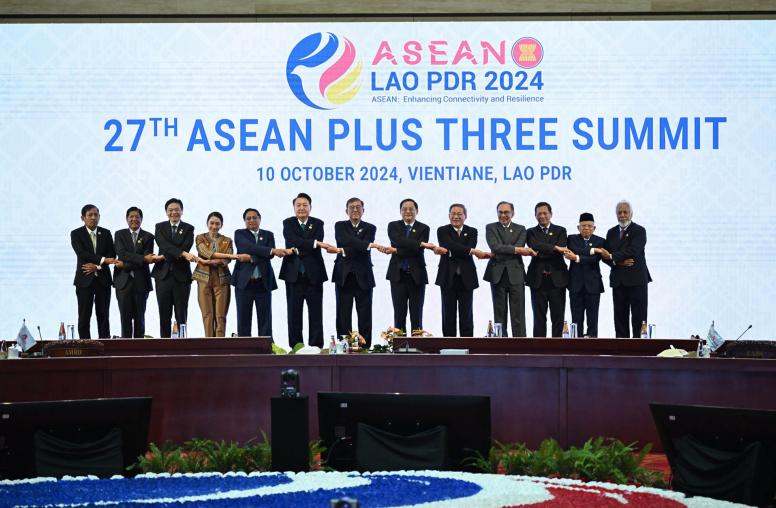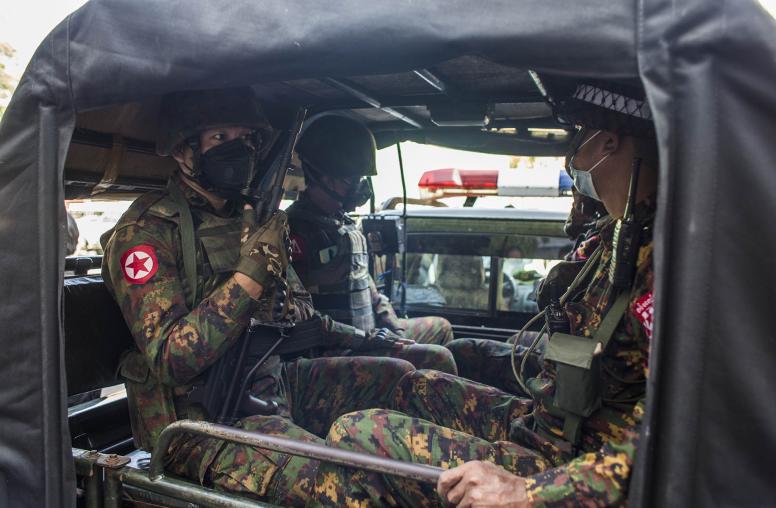Myanmar in the Streets: A Nonviolent Movement Shows Staying Power
In a historic uprising against a military coup, activists use tactics that have succeeded elsewhere — despite the generals’ escalating violence.
The people of Myanmar have opposed military rule in the past but never like this: In the face of horrific brutality by a lawless regime, Burmese have risen up in an historic national movement of nonviolent resistance. Led by young women, the fractious country has united across ethnic, generational and class lines, weaponizing social norms and social media in a refusal to accept the generals’ February 1 seizure of power. The broad appeal and tactical creativity of the resisters have kept the movement in the streets — and the generals off balance — for more than eight weeks now despite intensifying repression. While no one can predict the course of events in Myanmar, the campaign displays hallmarks of past nonviolent movements around the world that ultimately achieved their goals.

If coup leaders expected the population to fold after five liberating years of limited democracy and global integration, they were badly mistaken. Public protests have ballooned in virtually every township in Myanmar as the civil disobedience movement has continued to gain strength.
During the first few weeks of protest, the streets filled with creative and colorful activism — couples in their wedding dress, gamers in costume, professional athletes and body builders, hip hop dance troupes, and pet lovers with their dogs.
Then, as the military’s tactics evolved, the resistance adapted in kind.
When the soldiers unleashed water cannons, activists brought colorful umbrellas and baby pools. When military convoys mobilized throughout Yangon, common people clogged roadways by pretending to spill onions all over the street, faking car breakdowns or by simply driving very slowly. When the regime burned and bulldozed protective barricades, protesters hung beautiful longyis — a traditional Burmese article of clothing — on clothes lines across the streets to repel the soldiers who subscribe to the traditional belief that crossing beneath longyis saps their strength. When soldiers infiltrated neighborhoods, the community set up watch groups for protection and banged pots and pans, a customary practice to ward off evil spirits and a warning to the neighborhood to beware (as well as a time-honored tactic of nonviolent movements around the world). When the military began using live rounds and sniper fire on peaceful protesters, they built bunkers and wore protective equipment. When the movement felt fatigued, they called a stay-at-home strike.
A New Generation of Activists
Opposition to the coup began almost immediately when doctors and nurses, the heroes of the COVID-19 response, declared a national Civil Disobedience Movement (CDM) and went on strike. They were followed by teachers, shop owners, bankers and civil servants, among many others. By mid-March, only a third of the country’s hospitals were fully operational and a majority of the nearly 1.4 million government workers had joined the CDM.
Though the opposition this time has been generally leaderless and fluid — inspired by movements in Hong Kong and Thailand to “be water” — young people, especially young women of Generation Z, have demonstrated leadership in moments that demanded it. In the 1988 uprising, many women and girls fought bravely. Fewer, however, took leadership roles in the ways they do today, making important strategic decisions and standing on the front lines.
Generation X’s courageous 1988 uprising was violently crushed, marking the beginning of a 20-year period of military rule and leaving scars that last to this day. Generation Y, the millennials, has memories of the violent repression of the 2007 Saffron Revolution, but also of a negotiated political transition.
Gen Z’s approach to politics, activism and national identity is something different.
The 5 million young people who voted for the first time in November 2020 grew up in a thoroughly altered context, technologically connected to the world through social media and gaming, progressing (slowly) toward full democracy, and less bound by traditional norms of social hierarchy. While older generations expressed disapproval for hanging longyis, for example, Gen Z men marched in the street on International Women’s Day wearing longyis over their shoulder or even atop their heads, in blatant defiance of social norms. They have held protest signs with messages of inclusion and acceptance of traditionally marginalized groups. One said, “Down with Majoritarian Racism” while others even expressed remorse for their treatment of Rohingya.
As in the previous uprisings against military rule, though, the Tatmadaw, Myanmar’s military, is once again deploying extreme violence to suppress popular resistance and seeking to fracture the opposition while maintaining its own cohesion. But this time the opposition has achieved national scale and unity through inclusive organizing and skillful resistance tactics.
The Movement’s Strengths and Challenges
By design, the Myanmar movement incorporates features that scholars of nonviolent struggles know have proven most effective.
The leadership of young women in the movement is a key strength. Historic cases such as the 1986 “People Power” movement in the Philippines, in which nuns holding statues of the Virgin Mary stopped lines of government tanks, or the “Women of Liberia Mass Action for Peace” of the early 2000s speak to the power of mobilized women to stand up to violent repression and bring about change. When women participate on the frontlines of nonviolent movements, those movements are much more likely to succeed.
The movement’s diversity is another critical asset. Coalitions across ethnic groups and economic classes are central in nonviolent movements’ success, and the participation of trade unions and religious groups, both of which have been intimately involved in the movement in Myanmar, are essential.
Movements that employ a wide range of nonviolent tactics, and shift tactics in response to changing conditions, have historically had the most impact. In Myanmar, resistance organizers are using assorted tactics that have proven effective in countering military coups in other contexts, including social punishments for those who engage with the regime, noncooperation, and civil disobedience. Non-cooperation and civil disobedience efforts have been organized by trade unions, including 90 percent of the country’s truckers, thousands in the profitable garment export industry, and by hundreds of thousands of civil servants from across the government. Economic activity in Myanmar’s private sector has ground to a halt and recent reports indicate that the government is operating at about 10 percent of its normal capacity.
Nonviolence and Brutal Repression
Yet the sustained brutal repression by the Tatmadaw, with over 520 protesters killed and many thousands arrested, puts the movement at a crucial crossroads.
So far, most protesters have maintained nonviolent discipline, not taking up arms against the military even when faced with lethal violence. Yet research shows that when violent repression is sustained over time, breakdowns in nonviolent discipline become increasingly common as activists lose faith that nonviolent action can achieve change.
Moves by the country’s array of ethnic armed organizations (EAOs) may increase this challenge, turning the current conflict into full-scale civil war as in Syria, where ferocious crackdowns on peaceful protesters in 2011 precipitated a shift into violent conflict. An alternative outcome is also possible. By late March, the majority of EAOs in Myanmar had released statements condemning the coup and voicing solidarity with the CDM. As EAOs stand firmly against the military regime, protesters may be more ready to sustain their nonviolent discipline. Some may opt to join the ranks of the militants and support their efforts to counter the regime militarily.
Real, Inclusive Peace or Violence and Dictatorship?
For more than 70 years, Myanmar has faced cycles of violent conflict driven by an exclusionary narrative of national identity and belonging. Ethnic and religious minority populations have been repeatedly excluded, including by the Bamar Buddhist-dominated National League for Democracy government, for decades. Discriminatory policies on education, natural resource governance and religious practice, for example, that favor Bamar Buddhists over the nearly 150 ethnic minorities, have reified exclusionary narratives of who belongs.
Taking the most optimistic view, the common struggle against the military regime could be a starting point for reconciliation and a reconceptualization of national identity. The elected NLD government, most of which has gone into hiding or fled the country, have taken small steps toward reconciliation by appointing a Christian from Karen state as its leader, legalizing EAOs, and indicating a willingness to abolish the highly discriminatory 2008 constitution. Much more will need to be done to build durable trust.
While coming events in Myanmar will be shaped primarily by internal forces, the international community should do everything in its power to end the increasingly violent repression of peaceful protesters and sustain the current nonviolent movement. A way to do that would be to pressure companies and governments to cut ties with the military regime — particularly if violent repression continues. Another is to continue offering support and solidarity for the nonviolent movement in the streets. International actors could also support dialogue between EAOs, the Committee Representing the Pyidaunsu Hluttaw, ethnic political parties and civil society as they negotiate highly sensitive issues such as federal security structure and power-sharing that have the potential to divide them.
The people of Myanmar have shown great courage in forcefully rejecting this illegitimate coup. The international community should stand shoulder to shoulder with them to insist on a peaceful return to the democratic governance that they, at enormous personal risk, are demanding.
Zarchi Oo is the technical specialist for USIP’s Inter-Communal Harmony Program.



